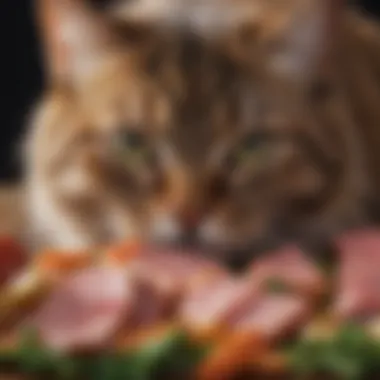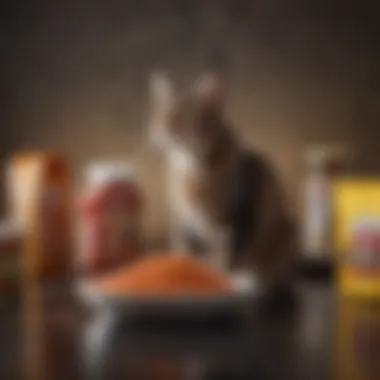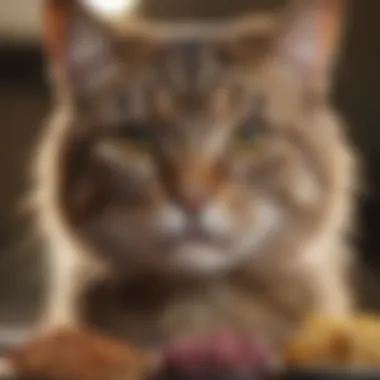Best and Worst Wet Cat Food: Essential Insights For Pet Owners


Intro
When it comes to ensuring the health and happiness of our feline companions, nutrition plays a pivotal role. Understanding which wet cat food options excel and which ones fall short is crucial for every pet owner. With a plethora of products available on the market, making informed choices can be overwhelming. This comprehensive guide aims to demystify the realm of wet cat food, analyzing both the best and the worst options while considering ingredient quality, nutritional content, and brand reputation. Here, we will also touch upon potential health concerns and emphasize the importance of tailoring dietary choices to meet the specific needs of your cat.
Animal Overview
Common Names
Domestic cats, often simply referred to as cats, belong to the Felidae family. They are known for their agility, independent nature, and companionship.
Scientific Classification
The domestic cat is scientifically classified as Felis catus. This classification reflects their evolutionary heritage and distinguishes them from their wild relatives.
Geographic Range
Cats are virtually found across the globe. Although originally domesticated in the Near East, they adapt well to various environments, from urban cityscapes to rural areas. Their versatility makes them a beloved pet in countless cultures.
Importance of Wet Cat Food
Wet cat food is an essential aspect of many cats' diets. Unlike dry kibble, wet food offers increased moisture content, aiding in hydration and enhancing palatability. This becomes particularly significant for cats that may not drink enough water on their own.
Nutritional Quality
High-quality wet cat food can provide superior nutrition. Key ingredients include real meat, essential vitamins, and minerals. It's vital for pet owners to read labels carefully, ensuring that primary protein sources are listed first. This helps guarantee the food meets a feline's nutritional requirements.
Brand Reputation
Reputable brands often invest in research and development, ensuring their products align with the latest veterinary nutrition guidelines. When examining different options, it's advisable to consider brands that have a proven track record of quality and transparency.
It's essential to consider your cat's unique dietary needs when selecting food. Factors such as age, weight, activity level, and health conditions all influence dietary choices.
Making Informed Choices
When selecting wet cat food, pet owners should evaluate multiple factors:
- Ingredients: Whole meats should be prioritized.
- Nutritional Content: Look for products that meet AAFCO guidelines.
- Brand Reviews: Research customer feedback and veterinary recommendations.
Prolusion to Wet Cat Food
Wet cat food plays a crucial role in ensuring the health and well-being of feline companions. Unlike dry kibble, wet food provides higher moisture content, which is essential for hydration and can help prevent urinary tract issues. Understanding the various types of wet cat food available and their respective benefits is necessary for any responsible pet owner.
Understanding Wet Cat Food
Wet cat food comes in several forms, including pates, chunks in gravy, and broths. These formats not only appeal to different tastes and preferences among cats but also impact nutritional absorption. Wet food typically contains a higher protein content, which is vital for a cat’s overall health. The moisture present in wet food also contributes to better hydration, an essential element for cats, particularly as they often do not drink sufficient water on their own.
When selecting a wet cat food, it is essential to scrutinize the ingredient list. Ingredients should be clearly defined, with a focus on animal proteins. It is also advisable to avoid products with fillers or artificial preservatives, as these can detract from the food's quality. Many high-quality brands offer a simple ingredient list that reflects their commitment to feline nutrition.
Nutritional Needs of Cats
Cats are obligate carnivores, meaning their diet primarily consists of meat. This nutritional requirement influences the type of wet cat foods that are suitable. Key components of a proper diet for cats include protein, fats, vitamins, and minerals. A well-balanced wet cat food should meet all these nutritional criteria.


In addition to protein, fats provide essential fatty acids and are vital for energy. Vitamins and minerals are also necessary for various bodily functions, including immune system support, bone health, and skin health.
Understanding a cat's unique dietary needs is crucial. Factors such as age, weight, and activity level play a significant role in determining how much and what type of wet food is appropriate. For example, kittens require more protein and calories for growth compared to adult cats, while senior cats may benefit from lower calorie options to prevent obesity.
Remember: A well-informed choice can have a lasting impact on your cat’s health. Always consult with a veterinarian to tailor a diet that meets your individual cat's nutritional requirements.
Criteria for Evaluating Wet Cat Food
When selecting wet cat food, several criteria must be considered to ensure that the chosen products meet the unique needs of your feline friend. Evaluating these factors is crucial for your cat's health and well-being. Ignoring these considerations could lead to long-term health issues. This section will focus on three major elements: ingredient quality, nutritional balance, and brand reputation.
Ingredient Quality
Ingredient quality is foundational when it comes to selecting wet cat food. High-quality ingredients typically contain real meat, fish, and vegetables, which provide essential nutrients. For instance, the first ingredient listed should ideally be a source of protein. Many manufacturers also include fillers like corn or soy, which can dilute the nutrient content.
When choosing cat food, look for products devoid of artificial preservatives, colors, or flavors. Natural ingredients not only offer better nutrition but also contribute to improved digestion and overall health. Additionally, it is wise to scrutinize the source of these ingredients. Brands that source locally or from trusted suppliers usually maintain higher standards of quality.
Lastly, examining the ingredient label gives insight into the food's overall quality. Avoid products with vague terms, or those that do not list specific meat sources, as this can be a red flag for poor quality.
Nutritional Balance
Nutritional balance refers to the appropriate ratio of protein, fats, vitamins, and minerals necessary for a cat's health. Cats are obligate carnivores, meaning that they require a diet rich in animal protein. While every cat's nutritional needs may vary slightly, a generally accepted balance is 30-40% protein and 15-25% fat. Carbohydrates should be limited since cats have a low dietary requirement for them.
Wet cat food should provide essential nutrients that support vital functions, such as maintaining a healthy coat, aiding digestion, and promoting strong immune systems. Products that offer complete and balanced nutrition should adhere to standards set by recognized organizations, like the Association of American Feed Control Officials (AAFCO). Look for labels indicating that the food is formulated to meet these standards. This can give you confidence that your cat is receiving all necessary nutrients for optimal health.
Brand Reputation
Brand reputation plays a significant role in decision-making when evaluating wet cat food. Established brands with a good track record often invest in research and quality control, leading to better products. This can also reflect in their transparency about sourcing, ingredient quality, and nutritional formulations.
Research consumer reviews and feedback on various platforms to identify brands with positive experiences or that are recommended by veterinarians. Unfavorable reviews or recurring complaints can point to potential issues regarding quality and service. Additionally, consider contacting the brand directly with any questions about their products. A responsive customer service team is often a strong indicator of a reliable brand.
In summary, evaluating wet cat food requires careful consideration of ingredient quality, nutritional balance, and brand reputation. Doing so not only helps ensure your cat receives optimal nutrition but also safeguards against the negative health implications of low-quality products.
Best Wet Cat Food Brands
The selection of wet cat food brands is substantial. Choosing the right one can directly impact your cat's health and overall well-being. The importance of identifying the best wet cat food brands lies in ensuring quality ingredients, balanced nutrition, and a reputable brand history. These brands often excel in providing options that cater to various dietary needs, allergies, and preferences that cats may have.
High-Quality Ingredients
Brand A
Brand A is notable for its commitment to using premium, high-quality ingredients. This focus enhances not only the taste but also the nutritional value of the food. The key characteristic of Brand A is its use of real meat as the primary ingredient, which is crucial for the feline diet. This appeals to health-conscious pet owners who prioritize ingredient transparency.
A unique feature of Brand A is its grain-free options. This can be beneficial for cats that may have sensitivities to grains, promoting easier digestion. However, one should note that these options might not suit every cat, especially if they do not have such issues.
Brand B
Brand B stands out due to its holistic approach to pet nutrition. The brand emphasizes the importance of balanced recipes that include not just protein, but also fruits and vegetables. This makes it a beneficial choice for providing a rounded diet. The brand incorporates vitamins and minerals to support overall health, which contributes significantly to its popularity among cat owners.
A key advantage of Brand B is its availability of various flavors and textures, which can be useful for picky eaters. Yet, some customers may find certain formulas to be cost-prohibitive compared to other brands on the market.
Nutritional Formulations
Brand


Brand C is recognized for its scientifically formulated recipes aimed at specific life stages of cats. This includes kitten-specific recipes that cater to the unique needs of growing felines. The standout characteristic of Brand C is its focus on protein and fat ratios, which are essential for energy and growth.
The unique feature of Brand C is its use of added omega fatty acids for skin and coat health. This can be particularly beneficial for cats prone to skin issues. However, due to its premium nature, it may not be the most economical choice for all pet owners.
Brand
Brand D offers specialized diets for cats facing particular health challenges, such as renal support or weight management. The highlight of Brand D is its ability to create formulations that target these health concerns effectively, often endorsed by veterinarians. This makes Brand D a popular choice for proactive cat owners.
One significant advantage is its detailed nutritional analyses available on packaging. However, the narrow focus on health-specific formulations can limit options for owners looking for general pet diet solutions.
Positive Customer Feedback
Brand E
Brand E has built a strong reputation based on positive customer feedback. Many cat owners highlight the palatability of this brand's products, indicating that even the fussiest cats enjoy them. This satisfaction is a key element in its inclusion in discussions about the best wet cat food.
The main characteristic of Brand E is its variety of flavors that cater to diverse cat preferences. A notable feature is the customer loyalty program which offers discounts to returning buyers. Some customers, however, express concerns about occasional product inconsistency.
Brand F
Brand F is another brand that enjoys a solid reputation based on customer reviews. It is often praised for its affordability without compromising quality. The key characteristic of Brand F is its transparent ingredient sourcing, which reassures pet owners about what they feed their cats.
Moreover, the unique feature of offering both wet and dry options provides flexibility for cat owners who prefer a mixed feeding approach. Nonetheless, some cat owners suggest that the texture may not be appealing to all cats, leading to mixed reviews from different households.
Worst Wet Cat Food Brands
Understanding the worst wet cat food brands is crucial for pet owners who want to offer a healthy diet to their feline companions. Choosing poor-quality food can lead to various health issues for cats over time. Recognizing specific problems in these products helps consumers make better decisions. This section covers common red flags, critically reviewed brands, and consumer complaints. Each element provides insight into the potential drawbacks of specific wet cat foods that should be avoided.
Common Red Flags
When evaluating wet cat food, you must watch for certain red flags. These indicators can hint at substandard quality, which could affect your cat's health negatively. Here are some common issues:
- Ingredient lists: Look for vague descriptions like "meat by-products". This can signal lower quality ingredients.
- Lack of nutritional information: Labels should include precise protein, fat, and carbohydrate contents. If these are missing, it raises concerns.
- Unrealistic claims: Be cautious of brands that promote miracle diets or highlight supposed health benefits without scientific backing.
- Poor packaging: Damaged or low-quality packaging can suggest a lack of attention to product integrity and environmental conditions during storage.
These red flags can indicate deeper issues with product formulation and overall quality, impacting your cat's health.
Critically Reviewed Brands
Brand
Brand X has been heavily criticized for its ingredient sourcing. One specific aspect is the use of low-quality protein sources. This can lead to an imbalanced diet for cats, who require high-quality protein for optimal health. A key characteristic of Brand X is the lack of transparency about its manufacturing processes. This raises questions about food safety and quality.
While Brand X might be marketed as a budget option, the unique feature is its overly processed recipes that can diminish nutritional value. This can pose significant disadvantages, making it less suitable for health-conscious pet owners.
Brand Y
Brand Y has also faced scrutiny for its formulation. One specific aspect is the frequent inclusion of artificial preservatives and fillers. These additives can be harmful to cats over time and offer little to no nutritional benefit. A key characteristic of Brand Y is its appealing marketing, which can mask its subpar quality.
The unique feature of Brand Y is its wide range of flavors, but more often than not, this diversity does not compensate for the lack of essential nutrients. Like Brand X, Brand Y also falls short in providing what cats truly need for their health.
Consumer Complaints
Consumer complaints typically center around several issues. First, many pet owners report their cats having adverse reactions after consuming these brands. Problems like vomiting, diarrhea, and lack of energy are common. Second, there is often dissatisfaction regarding the value for money. Users feel they are not receiving premium ingredients for their investment.


Health Implications of Poor Quality Wet Cat Food
Understanding the health implications of poor quality wet cat food is crucial for cat owners who wish to prioritize their pet's well-being. This section will examine how substandard food choices can adversely affect your cat's health and overall quality of life. Poor quality wet cat foods often contain low-grade ingredients that lack essential nutrients, potentially leading to serious health problems. While it may be convenient to choose cheaper options, the long-term consequences of these decisions can outweigh the initial savings.
A thorough exploration of the health risks associated with poor-quality wet cat food can empower pet owners to make informed dietary choices. Recognizing how these factors come into play is vital for ensuring your feline companion receives the best possible nutrition.
Digestive Issues
Many cats experience digestive issues as a result of consuming low-quality wet cat foods. These problems can manifest in several ways, including vomiting, diarrhea, and constipation. Low-quality ingredients often come with fillers, such as corn or wheat, which can be challenging for cats to digest. Moreover, these foods may lack sufficient moisture content, leading to dehydration and complicating digestive health further.
When cats have a healthy digestive system, they can absorb essential nutrients effectively. In contrast, frequent digestive disruptions can impair nutrient absorption, leaving your pet short on vital vitamins and minerals. Owners should observe their cat's bowel movements and overall behavior. If any irregularities arise, it may indicate that the food is unsuitable.
Transitioning Your Cat to Better Food Options
Transitioning your cat to better food options is an important undertaking that can significantly impact their overall health and well-being. Many cats develop habits around specific types of food, making the switch both a sensitive and necessary process. It becomes essential to consider the specific nutritional needs of your cat, their preferences, and any health concerns that may influence their diet. Choosing high-quality wet cat food can enhance their hydration, improve digestion, and support overall health.
A well-planned transition can promote positive outcomes for your cat, leading to better nutrient absorption and a happier lifestyle. Moreover, by informing yourself about ingredient quality and nutritional balance, you empower yourself to make informed choices about your pet’s diet. This meticulous approach can mitigate potential digestive risks during the transition and creates a foundation for establishing a long-term healthy eating pattern.
Step-by-Step Transition Guide
- Assess Current Diet: Begin by evaluating the cat's current food. Take note of its ingredients, nutritional value, and your cat's reaction to it.
- Choose New Wet Food: Opt for a high-quality wet food brand recognized for its nutritional content, such as Royal Canin or Hill’s Science Diet.
- Gradual Introduction: Introduce the new wet food slowly. Start by mixing a small amount of the new food with the current food, gradually increasing the proportion of the new option over a week or two.
- Monitor Reactions: Keep an eye on your cat’s reactions during this transition. Look for signs of digestive distress or preferences for the new food.
- Adjust as Needed: If your cat seems sensitive to the switch, consider further delaying the introduction. Adjust the mix ratio to ensure a smoother experience, prioritizing your cat’s comfort.
It is crucial to take your time with each step. A rushed transition may lead to gastrointestinal upset or aversion to the new food.
Monitoring Your Cat's Health
Monitoring your cat’s health during and after the transition to a better food option is essential. Pay attention to several indicators that reflect health status. Regular checks can help identify issues early and ensure that the transition is positively affecting your cat's well-being.
- Digestive Health: Observe stool consistency and any signs of discomfort. Unusual behaviors such as excessive vomiting or diarrhea indicate a potential problem.
- Energy Levels: Keep track of your cat’s energy levels. An increase or decrease in energy can signal how well they are adjusting to the new food.
- Coat Condition: A shiny and healthy coat often indicates proper nutrition. If you notice changes in your cat's coat, it might suggest dietary deficiencies or adjustments needed.
- Weight Management: Monitor your cat’s weight to ensure it remains within a healthy range. Sudden weight gain or loss during the transition may require further evaluation.
Keeping a journal tracking your cat’s health during the transition can help you notice patterns or issues over time.
Culmination
This article emphasizes the significance of understanding wet cat food, specifically regarding the selection of the best and worst options available in the market. Choosing the appropriate wet cat food is not just about satisfying immediate hunger; it is about ensuring the long-term health and well-being of your feline companion. This guide has unpacked various important elements such as ingredient quality, nutritional balance, and brand reputation.
By taking the time to evaluate these factors, pet owners can make informed choices that contribute positively to their cat’s dietary welfare.
The health implications of poor-quality food can be severe, leading to digestive issues and other long-term health risks. Assessing the nutritional content of products is essential.
Incorporating high-quality wet cat food can result in noticeable improvements in your cat's behavior, coat condition, and overall vitality. Moreover, being proactive in transitioning to better food options can further enhance their quality of life.
Thus, the insights provided in this guide serve as a vital resource for cat owners aiming for a conscientious approach to food selection, ensuring that their pets thrive and lead healthier lives.
Making Informed Choices for Your Cat
When selecting wet cat food, several essential considerations come into play. The first step involves understanding your cat's unique nutritional needs. Every cat has distinct requirements based on their age, health condition, and activity level.
Next, pet owners should examine the ingredient list on each product. High-quality ingredients typically include real meats, vegetables, and grains, while fillers and artificial additives should be avoided. Look for products with named animal proteins as the first ingredient. This ensures that your cat receives the necessary protein for optimal health.
For a more tailored approach, consider consulting with a veterinarian. They can provide personalized recommendations based on your cat's health profile.
In addition, taking into account brand reputation is critical. Brands that invest in quality controls and transparent sourcing are generally more reliable. Look for feedback from other pet owners; consistent positive reviews can be a good indicator of a brand’s reliability.
Here are some helpful tips to guide your selection:
- Read Labels Carefully: Be aware of ingredients that may be harmful or unnecessary.
- Prioritize Quality over Quantity: A higher price does not always equate to better quality, but very low prices often indicate lower-quality ingredients.
- Trial and Monitoring: When switching foods, introduce new options gradually and monitor your cat's reaction.
- Consider Specialized Needs: Some cats may require specialized diets for health reasons, so check for vet-approved options.
By taking all these aspects into consideration, you will be better equipped to choose the best wet cat food that meets your cat's specific nutritional needs while enhancing their overall health.







